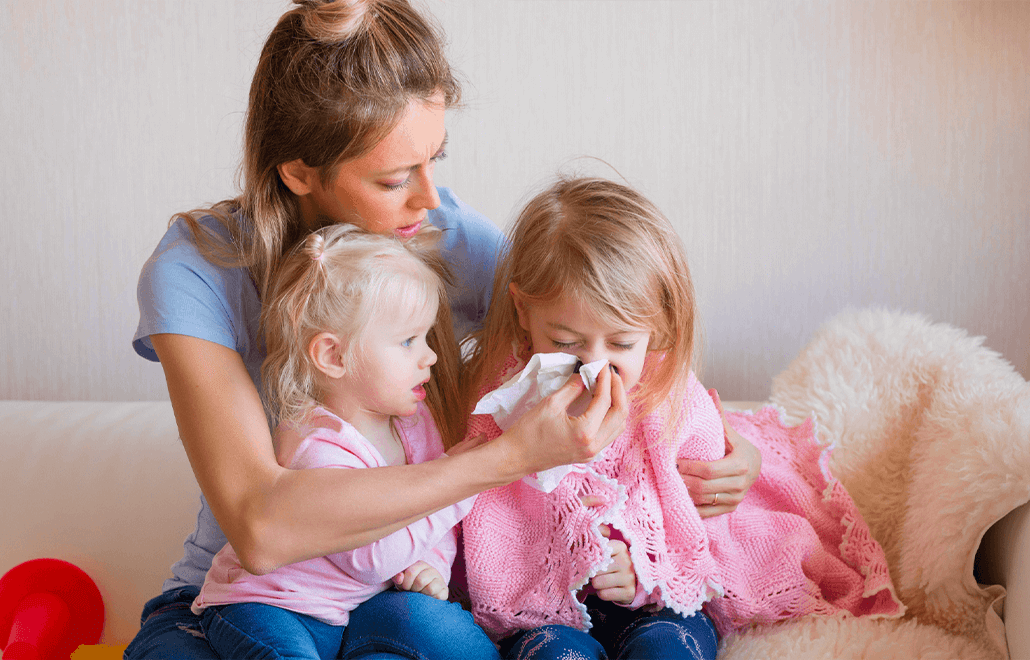
14 Nov Managing Winter Allergies in Children
3 min. readThe winter season brings with it the promise of snowflakes, cozy sweaters, and the magic of the holidays. However, it also comes with its fair share of health challenges, especially for children who suffer from winter allergies. While spring and summer allergies are often more well-known, winter allergies can be equally bothersome. As a parent, understanding and managing these allergies is essential to ensure your child enjoys the season to the fullest.
Common Winter Allergens
Winter allergies are usually triggered by indoor allergens. Here are some common culprits:
1. Dust Mites: These tiny creatures thrive in the warmth and humidity of our homes, making bedding and soft furnishings a breeding ground. Dust mite droppings can cause allergic reactions in some children.
2. Mold: Mold spores are released into the air and can be inhaled, triggering allergic reactions. In the winter, molds often grow in damp and poorly ventilated areas.
3. Pet Dander: Spending more time indoors means increased exposure to pet dander, especially if your child has allergies to cats, dogs, or other furry pets.
4. Indoor Irritants: Wood-burning stoves, fireplaces, and space heaters can release particulate matter into the air, causing respiratory issues for some children.
Symptoms of Winter Allergies
Winter allergies can present with a range of symptoms, including:
1. Sneezing
2. Runny or Stuffy Nose
3. Coughing
4. Itchy or Watery Eyes
5. Wheezing and Shortness of Breath
6. Skin Rashes or Hives
Tips for Managing Winter Allergies
Here are some strategies to help manage and alleviate your child’s winter allergies:
1. Maintain a Clean Environment: Regularly clean and vacuum your home to reduce allergen exposure. Use allergen-proof covers on pillows and mattresses to keep dust mites at bay.
2. Humidity Control: Maintain proper humidity levels in your home to discourage dust mites and mold growth. Using a dehumidifier can help.
3. Pet Care: Bathe and groom your pets regularly. Create pet-free zones in the house, especially in your child’s bedroom.
4. Avoid Smoke and Fumes: Keep your child away from tobacco smoke and reduce exposure to wood-burning stoves and fireplaces.
5. Wash Bedding: Wash your child’s bedding and stuffed animals in hot water (130°F or higher) to kill dust mites.
6. Allergen-Free Filters: Consider using HEPA filters in your home’s heating and cooling systems to trap airborne allergens.
7. Consult a Pediatrician: If your child’s symptoms persist or worsen, it’s essential to consult your pediatrician. They can help identify specific allergens and recommend the appropriate treatment.
8. Medications: Your pediatrician may prescribe antihistamines, decongestants, or allergy shots to manage more severe cases.
Enjoying the Winter Season
While winter allergies can be bothersome, they shouldn’t prevent your child from enjoying the magic of the season. By following these tips and working with your pediatrician, you can help manage their allergies effectively. The winter season should be a time of joy and fun, and with the right care, your child can embrace it fully.
At Continuum Pediatrics, we’re here to support you and your child’s health, whatever the season. If you have concerns about your child’s allergies or need guidance on managing winter allergies, please don’t hesitate to reach out to our dedicated team of pediatricians. We wish you a happy and healthy winter season!

